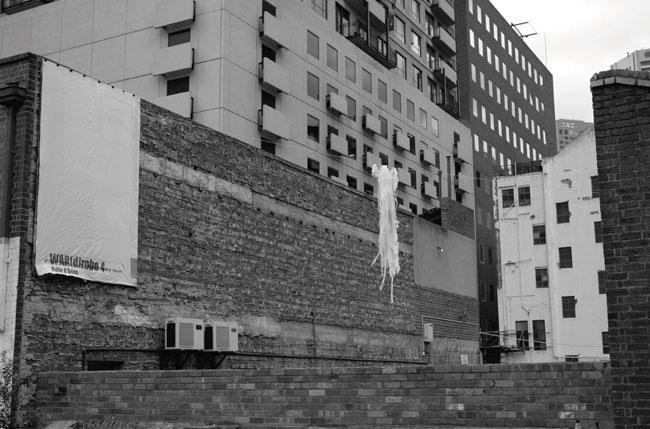 |
||||||
|
Urban Threads was an ephemeral urban installation that explored the ways in which those without land, money and power shape the urban fabric; in particular, the private territories that are staked out in the public realm and the spatial practices that connect them. It was a collaboration between architect and academic, Janet McGaw, and five homeless women in Melbourne, Australia in October 2004. Nine sites, located in interstices in Melbourne’s urban fabric, housed imaginary domestic rooms including “bedrooms” and “WAR(d)robes”, a “dining room” and a “Living Room”. They were made from discarded garments and other urban waste, reconfigured with scissors and cable ties. The most intimate and minimal shelters were inscribed: clothes and chrysalises. Each explored the women’s personal experiences of strangulating expectations, intimidation, loss, invisibility, dependence and hope. The installation and the collaboration that produced it was an exercise in praxis, testing the theories of both Michel de Certeau, who observed that the apparently powerless can use movement and timing to usurp control from the strong and Elizabeth Grosz, who asserts that bodies and cities co-create one another. A trajectory connected the sites which we called “The Path of Most Resistance (and Least Distance)”. This was a performative line, along which observers could (t)read the installation. Over the two weeks that the installation was in place, it gradually disappeared through acts of deliberate vandalism, wild weather, quirks of fate, and thoughtful interactions from passers-by. The changes were acknowledged by McGaw with inscriptions of graffiti over the plastic skin that contained the ‘rooms’. The ‘room’ depicted in the image is “WAR(d)robe 4: distant memories, lost dreams, faded hopes”, by Kylie O’Brien. It is white flowing gown with tendrils of plastic shopping bags, reminiscent of Miss Havisham’s wedding garb, hung between an existing carpark floodlight and a dilapidated billboard. By day it hovered, white and solitary, in space. At night it transformed into an enigmatic silhouette, dancing above the rooftops of one of Melbourne’s lanes. Traditionally materials have been thought to occupy two categories: the durable and the ephemeral. Sociologist, Michael Thompson identifies a third, covert category: rubbish. It is defined neither by it durablity nor its ephemerality, but by its flexibility. It has the status of maximum potential. WAR(d)robe 4, like the other ‘rooms’ in Urban Threads, uses apparent waste to usurp the space of commerce for a brief fortnight to tell the stories of the city’s most marginal occupants. Urban Threads had specific, personal, and at times, transformational effects on the participants. It has a broader relevance, though, as a model for academics to engage in praxis as a type of research. Without access to land or building materials, the output of creative research is usually limited to drawing, virtual designs, or prototypes made in the confines of the academe or gallery spaces. This installation demonstrates that academics can also present their ideas as forms, spatial practices, and material objects in an urban context, thereby entering into the process of shaping the urban fabric. Participants Acknowledgments |
 |
||||||
|